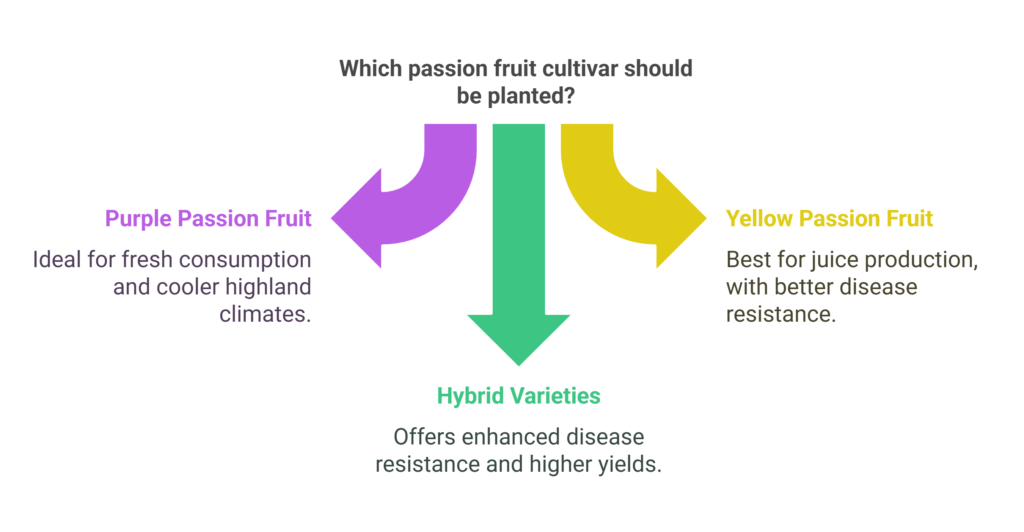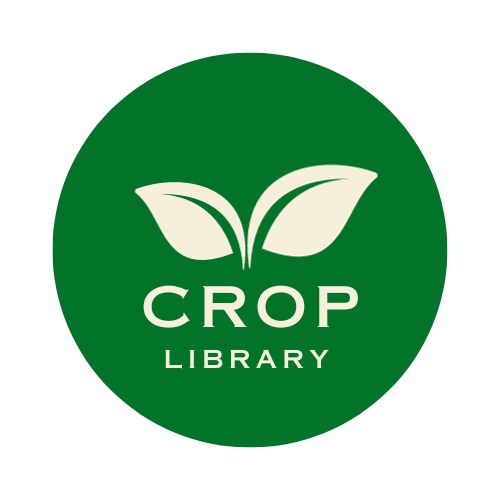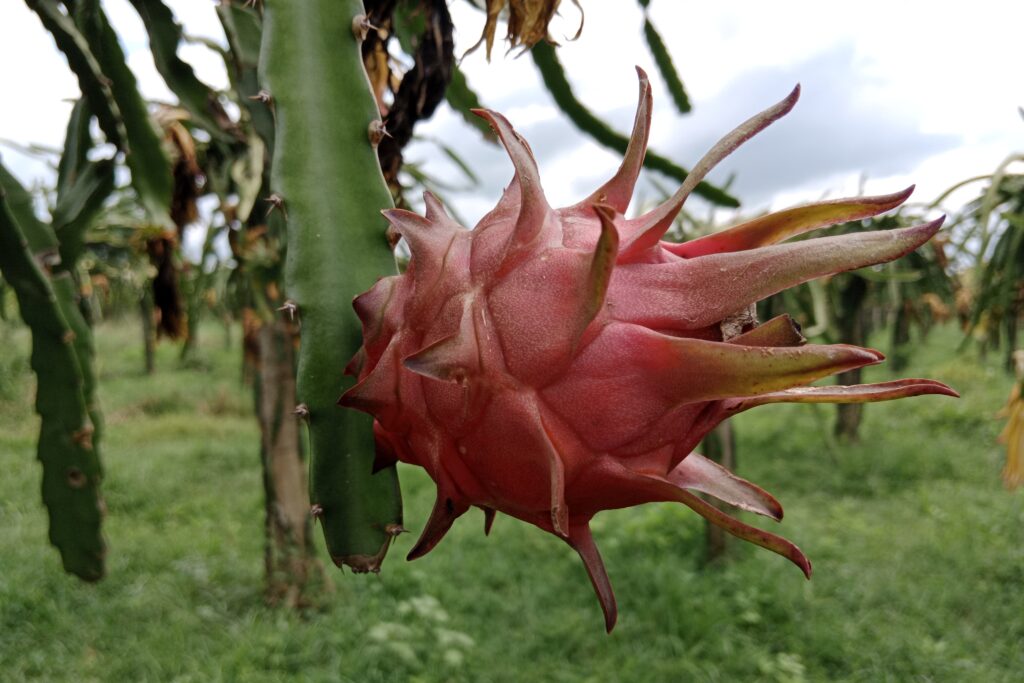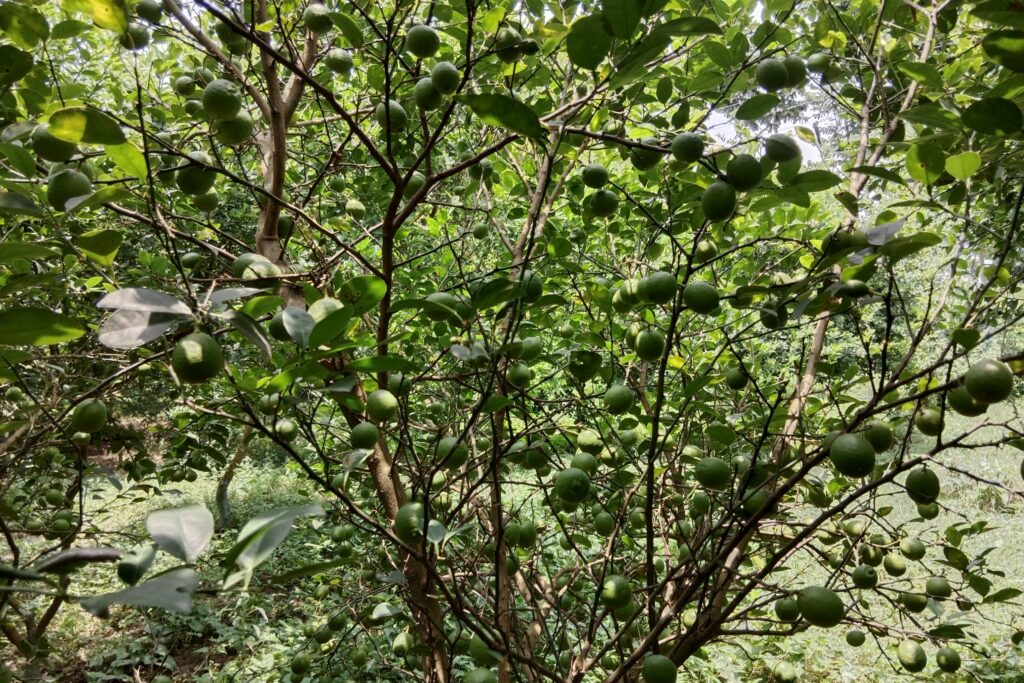Passion Fruit Farming
Passion fruit farming profit per acre depends on proper cultivation of Passiflora edulis, a fast-growing tropical vine requiring ideal soil, climate, and management. This high-value crop thrives in hot, humid regions with well-drained soils.
Pollination varies by variety: purple types often self-pollinate, while yellow varieties need cross-pollination (carpenter bees are ideal; honeybees work poorly). For low-pollinator areas or tricky varieties like giant granadilla, hand pollination ensures fruit set. Commercial growers maintain diverse plants for cross-pollination, while home gardeners can transfer pollen manually. Below is a full passion fruit farming guide covering land prep, pest control, and yield optimization for maximum profit per acre.

Passion fruit farming profit per acre varies significantly based on the cultivation system employed, with the trellis system offering higher long-term profitability. With 675 plants per acre, the trellis system requires an initial investment of NRs. 619,000, plus NRs. 400,000 for maintenance over Years 2–5, totaling NRs. 1,019,000. It yields 33,500 kg of fruit over five years, generating NRs. 3,350,000 in income and a net profit of NRs. 2,331,000 (NRs. 466,200 annually), making it ideal for commercial farmers seeking substantial long-term gains.
Conversely, the pole system, suitable for small-scale farmers with budget constraints, accommodates 540 plants per acre at a cost of NRs. 875,000 (NRs. 475,000 initial investment and NRs. 400,000 maintenance). It produces 26,000 kg of fruit, yielding NRs. 2,600,000 in income and a net profit of NRs. 1,725,000 (NRs. 345,000 annually). Over five years, the trellis system generates NRs. 606,000 more profit and breaks even earlier (Year 2 versus mid-Year 3 for the pole system). Additionally, price surges (e.g., NRs. 150/kg) can boost profits by up to 50%, while export opportunities to India and Gulf markets further enhance income potential.
Land Preparation
Proper land preparation for passion fruit cultivation involves clearing weeds, bushes, and debris, followed by plowing and harrowing to create a fine, loose tilth that promotes healthy root development, while ensuring adequate drainage to prevent waterlogging—on sloped terrain, contour farming should be implemented to minimize soil erosion and maintain soil fertility.
Soil Type
Rich in organic matter, well-drained loamy or sandy loam soils with a pH of 6.0 to 7.0—slightly acidic to neutral—are ideal for passion fruit growth. Heavy clay soils should be avoided because of their poor drainage, which raises the risk of waterlogging and root rot.
Climatic Requirements
While purple passion fruit (Passiflora edulis) does best at higher elevations (1,200–1,800 meters above sea level), the yellow variety (P. edulis f. flavicarpa) adapts better to lower elevations (0–1,500 meters). Passion fruit grows best in tropical to subtropical climates with ideal temperatures between 20°C.
Major Cultivars
Passion fruit requires pollination, with purple types often self-fertile but yellow varieties needing cross-pollination from genetically different plants. Carpenter bees are ideal pollinators (attracted to hollow logs), while honeybees work poorly except for small purple flowers. For giant granadilla (heat-sensitive) or areas lacking bees, hand pollination ensures fruit set. Growers should plant diverse vines for compatibility; home gardeners may need manual pollination.

a). Purple Passion Fruit (Passiflora edulis)
The purple passion fruit (Passiflora edulis) is favored for fresh consumption due to its sweeter, less acidic flavor profile and thrives particularly well in cooler highland climates, making it ideal for cultivation in temperate regions. The purple passion fruit (Passiflora edulis) is favored for fresh consumption due to its sweeter, less acidic flavor profile and thrives particularly well in cooler highland climates, making it ideal for cultivation in temperate regions.
b). Yellow Passion Fruit (Passiflora edulis f. flavicarpa)
Known for its increased acidity, yellow passion fruit (Passiflora edulis f. flavicarpa) is grown mainly for juice production. It has better disease resistance and grows more vigorously than purple variants.
c). Hybrid Varieties
Hybrid passion fruit varieties like KPF-4 and KPF-12 have been specifically developed to offer enhanced disease resistance and significantly higher yields compared to traditional cultivars.
Planting
Planting should be done in square system of planting.

a). Planting Season
Passion fruit cultivation is optimally initiated at the beginning of the rainy season to ensure proper plant establishment, though year-round planting is feasible in irrigated systems. The crop begins production within 6-8 months, with yellow varieties typically maturing earlier than purple cultivars. Harvest timing is determined by visual cues: purple fruits develop a deep violet color with slight wrinkling, while yellow varieties achieve a golden hue and natural abscission when ripe.
Farmers conduct selective hand harvesting at weekly to 10-day intervals during the production season. With appropriate agronomic management, including optimal planting timing and harvest practices, commercial plantations can achieve annual yields of 10-20 tons per acre, highlighting the crop’s significant profitability potential when managed correctly.
b). Spacing
Trellis System
The trellis system is commonly used in commercial passion fruit farming for optimal vine support and yield. In this method, rows are spaced 3 meters apart to allow adequate room for trellis installation, worker access, and sunlight penetration. Plants are spaced 2 meters apart within rows, ensuring each vine has sufficient space to grow without overcrowding. This spacing promotes better air circulation (reducing disease risk) and facilitates efficient management practices like pruning, pest control, and harvesting. The trellis structure (usually wires or ropes) supports vertical vine growth, maximizing fruit production per unit area.
Pole System
The pole system is ideal for small-scale or backyard passion fruit cultivation, where space or resources for trellises may be limited. Plants are spaced 2.5 meters apart between rows and 3 meters apart within rows, accommodating individual poles (e.g., wooden or bamboo stakes) for each vine. This wider spacing allows vines to spread naturally with less intensive management. While simpler and cheaper to establish, the pole system typically yields less than trellised farms due to limited vine training and light exposure. However, it remains practical for low-input farming or areas with labor constraints.
c). Pit Preparation
Proper pit preparation begins with excavating 60×60×60 cm (2×2×2 ft) holes. Enrich each pit by incorporating 10-15 kg of well-decomposed organic manure and 100 g of bone meal into the topsoil. During planting, further enhance the soil with 15 kg of farmyard manure (FYM) and 50 g of Trichoderma viride biological fungicide per pit. This comprehensive soil amendment strategy promotes vigorous vine establishment while effectively suppressing soil-borne pathogens responsible for root rot and crown rot diseases.”
d). Planting Method
When planting passion fruit seedlings, handle them carefully to prevent root damage, water thoroughly immediately after planting to help establishment, and apply mulch around the base of each plant to conserve soil moisture and suppress weed growth.
e). Number of Plants per Acre
- Trellis System: 675 plants per acre.
- Pole System: 540 plants per acre.
Intercropping
Passion fruit can be intercropped with low-growing companion plants like beans, peas, or leafy vegetables during its early growth stages, though tall crops such as maize should be avoided as they may compete for sunlight and shade the developing passion fruit vines.
Irrigation
Passion fruit plants require frequent watering (2-3 times per week) during their initial growth phase to ensure proper establishment, transitioning to deep weekly irrigation for mature vines (ideally using drip systems), while reducing water during flowering to promote better fruit development and yield.
Fertilizers and Manure
| Growth Stage | Fertilizer/Manure Application | Quantity per Plant |
| At Planting | Well-decomposed manure + DAP | 10–15 kg manure + 100 g DAP + 50g T. viridae + 100g neem cake |
| 3 Months After Planting | NPK (17:17:17) + Manure | 200 g NPK + 5 kg manure |
| Every 3 Months | Repeat manure application | 5 kg manure |
| Flowering/Fruiting | Potassium-rich fertilizer (e.g., SOP) | 100 g SOP |
Weed Control
Effective weed control in passion fruit cultivation involves manual weeding during the initial 3-4 months while being cautious of shallow roots, supplemented by mulching to suppress weed growth and retain soil moisture, with careful application of glyphosate-based herbicides when necessary, ensuring vines remain unsprayed to prevent damage.
Pest and Disease Management
Major Pests
a). Root Knot Nematodes
Root-knot nematodes (Meloidogyne javanica) are major pests of passionfruit, causing root galls and decline, along with fungal pathogens like Phytophthora and Fusarium. While yellow passionfruit shows some resistance, management requires healthy seedlings, crop rotation with non-host plants, solarization, fallow periods, and nematicides for effective control.
a). Fruit Fly (Bactrocera spp.)
Fruit flies cause significant damage to Passiflora species by feeding on flowering buds and green fruits, where adult females lay eggs that distort the fruit surface, while the hatching larvae feed on the pulp, introducing bacterial and fungal contamination that leads to premature fruit drop – small fruits may shrivel and fall, while developed fruits may mature with visible skin blemishes, wrinkling, and internal breakdown.
Management
- Use traps, bait sprays, or neem-based pesticides.
- Key natural enemies include parasitoid wasps like Opius fletcheri, which help control infestations by targeting fruit fly larvae.

b). Aphids
Aphids cause foliar deformation and serve as critical vectors for viral diseases, including Myzus persicae and Aphis gossypii transmitting fruit-hardening viruses, while M. persicae and M. solanifolii spread passion fruit woodiness virus; natural aphid control involves predators like Scymnus beetles, Chrysoperla lacewings, and Syrphus flies, alongside parasitoids such as Lysiphlebus testaceipes and Aphidius colemani for effective biological management.
Management
- Spray with an imidacloprid of 1 ml per litre water.
c). Mealy bug
Severe mealybug infestations can lead to loss of plant vigor, premature leaf drop, fruit deformation, and even plant death if left uncontrolled. Fortunately, natural biological control agents exist, including predatory beetles like Cryptolaemus montrouzieri and Harmonia octomaculata, lacewing larvae, as well as parasitic wasps such as Coccophagus species, Anagyrus coccidivorus, A. pseudococci, Leptomastidea abnormis, and Leptomatrix dactylopii, which help manage mealybug populations effectively.
Management
- Spray with an imidacloprid of 1 ml per litre water.
d). Thrips
Thrips damage passion fruit plants by feeding on young leaves, buds, and fruits, causing silvering, scarring, and deformities while also potentially transmitting viral diseases; natural predators like minute pirate bugs (Orius spp.) and lacewing larvae (Chrysoperla spp.) help control infestations, though severe cases may require neem-based treatments or spinosad applications for effective management.
Management
- Use spinosad or neem oil @ 3-5 ml /litre water.
Major Diseases
a). Fusarium Wilt
Fusarium oxysporum causes Fusarium wilt in passion fruit, characterized by pale green leaves, wilting, and plant death, with vascular darkening in roots and stems. The fungus spreads via soil-borne chlamydospores, entering through root injuries and moving systemically. It thrives in sandy soils under high humidity and is spread by water, tools, or contaminated soil.
Management
- Using resistant rootstocks, healthy seedlings, and minimizing root damage.
- Avoid waterlogging.
b). Collar rot
Fungi Fusarium solani and Haematonectria haematococca cause collar rot, which results in wilting, yellowing of the leaves, and plant death from collar necrosis, frequently accompanied by purple lesions and cracks in the bark. It usually strikes plants 1-2 years after they are planted and spreads by contaminated seedlings, wounds, or diseased soil. The disease is favored by high temperatures and humidity, and it is exacerbated by nematodes and inadequate drainage.
Management
- Spray copper oxychloride 3g / liter water.
- Avoiding diseased fields, enhancing drainage, and minimizing collar injuries are all parts of management.
- In the long run, resistant rootstocks are the best option.
c). Anthracnose
Colletotrichum gloeosporioides cause anthracnose in passion fruit, leading to defoliation, twig wilt, and fruit rot. Symptoms include dark brown leaf spots (1 cm diameter) that turn brittle, branch cankers, and sunken gray-brown fruit lesions. Under humidity, orange spores form on lesions. The fungus spreads via rain, infected plant material, and thrives at 27°C with prolonged wetness.
Management
- Plant disease-free seedlings, pruning infected parts, improved airflow, and avoiding wet harvests.
- Spray effective fungicides include benzimidazoles, chlorothalonil, and tebuconazole weekly in heavy rains or biweekly in mild conditions.
- Post-harvest, prochloraz, imazalil, or hot water treatment (42.5–45°C for 8 minutes) reduce infections.
d). Scab
Scab, caused by Cladosporium oxysporum, appears as small, round leaf spots that turn necrotic with greenish-gray centers, often deforming and perforating leaves. Similar lesions on twigs become sunken cankers, weakening branches, while fruit spots darken and cork-like but don’t affect pulp quality. The disease thrives in humid conditions, spreading via wind, water, or infected seedlings, with young tissues most vulnerable.
Management
- Applying fungicides like tebuconazole, mancozeb, or copper oxychloride during active growth and flowering.
- Avoiding overcrowded nurseries, ensuring good airflow, pruning infected parts.
e). Brown Spot
Alternaria passiflorae and A. alternata cause brown spot disease in passion fruit, characterized by reddish-brown zonate leaf spots (up to 2 cm), twig lesions, and sunken fruit spots that reduce commercial value. A. alternata produces smaller spots with chlorotic halos. The fungi spread via wind, rain, and infected seedlings, thriving in humid, warm conditions. Symptoms appear within 4-10 days, with the pathogen persisting year-round in plant debris.
Management
- Apply fungicide (copper compounds, carbamates, strobilurins) at 7–14-day intervals.
- Using tolerant hybrids with fungicides provides better control than treating susceptible varieties.
d). Woodiness Virus:
Passion fruit woodiness disease, caused by PWV and CWV, leads to stunted growth, leaf mosaic/rugosity, and woody, deformed fruits. The viruses spread primarily through aphids (non-persistent transmission) and contaminated tools during pruning.
Management
Since chemical aphid control proves ineffective against passion fruit woodiness viruses, integrated management focuses on prevention through rigorous sanitation practices including using certified virus-free seedlings, removing abandoned orchards before replanting, and sterilizing pruning tools to prevent mechanical transmission. Critical control measures involve eliminating potential virus reservoirs by avoiding legume intercrops near plantations and conducting frequent field inspections to rogue infected plants during the first five months after transplanting. While aphid vector suppression provides limited benefit, these phytosanitary measures collectively reduce virus spread and minimize economic losses in passion fruit production.
Harvesting
Passion fruit reaches first harvest 6-8 months after planting (typically sooner for yellow varieties). Purple varieties are ready when fruits develop deep purple coloration with slight skin wrinkling, while yellow varieties ripen to bright yellow and drop naturally. Farmers should handpick fruits at 7-10 day intervals during the harvesting season. With proper cultivation practices, commercial plantations can achieve yields of 10-20 tons per acre annually, making passion fruit a potentially lucrative crop when harvested at optimal maturity.
Cost of Investment for Passion fruit Farming per Acre
| S.N. | Categories | Trellis System (NRs.) | Pole System (NRs.) |
| 1 | Land Preparation (Plowing, Leveling) | 50,000 | 40,000 |
| 2 | Passion Fruit Saplings | 169,000 | 135,000 |
| 3 | Fertilizers & Manure | 150,000 | 120,000 |
| 4 | Irrigation (Drip System) | 150,000 | 100,000 |
| 5 | Labor (Planting & Maintenance) | 40,000 | 30,000 |
| 6 | Pest & Disease Control | 30,000 | 25,000 |
| 7 | Miscellaneous (Equipment, Mulch, etc.) | 30,000 | 25,000 |
| Total Initial Investment | 619,000 | 475,000 |
Annual Maintenance Cost
The annual maintenance cost for both trellis and pole systems ranges between NRs. 100,000 to 150,000 per acre from the second year onward, covering essential expenses like labor, fertilizers, pest control, and irrigation maintenance to sustain optimal passion fruit production throughout the cultivation period.
Income from Passion Fruit Farming Per Acre
| Year | Trellis Yield (kg/acre) | Pole Yield (kg/acre) | Rate (NRs. /kg) | Trellis Income (NRs.) | Pole Income (NRs.) |
| 1st Year | 1,500 kg | 1,000 kg | 100 | 150,000 | 100,000 |
| 2nd Year | 9,000 kg | 7,000 kg | 100 | 900,000 | 700,000 |
| 3rd Year | 12,000 kg | 10,000 kg | 100 | 1,200,000 | 1,000,000 |
| 4th Year | 8,000 kg | 6,000 kg | 100 | 800,000 | 600,000 |
| 5th Year | 3,000 kg | 2,000 kg | 100 | 300,000 | 200,000 |
| Total Income (5 Years) | 33,500 kg | 26,000 kg | – | 3,350,000 | 2,600,000 |
Analysis of Passion Fruit Farming Profit Per Acre
a). Trellis System (675 plants/acre)
The trellis system requires a higher initial investment of NRs. 619,000 plus NRs. 400,000 in maintenance costs over Years 2-5, totaling NRs. 1,019,000 for five years but generates substantial returns with NRs. 3,350,000 incomes from 33,500 kg yield, resulting in an impressive net profit of NRs. 2,331,000 (NRs. 466,200 annually), demonstrating its superior profitability for farmers who can afford the upfront costs and seek maximum long-term yields.
b). Pole System (540 plants/acre)
The pole system, with an initial investment of NRs. 475,000 and an additional NR. 400,000 in maintenance costs over Years 2–5, accumulates a total 5-year cost of NRs. 875,000; however, with a total income of NRs. 2,600,000 from 26,000 kg of yield, it delivers a net profit of NRs. 1,725,000, averaging NRs. 345,000 annually, making it a viable option for farmers with limited capital seeking moderate but stable returns.
c). Key Findings & Recommendations
i). Higher Profit in Trellis System
The trellis system, while requiring a greater upfront investment, proves significantly more profitable in the long run, generating an additional NRs. 606,000 over five years compared to the pole the higher initial costs for serious agricultural enterprises.
ii). Pole System is Cheaper but Less Profitable
The pole system offers a more budget-friendly initial investment but delivers lower yields (26,000 kg vs. 33,500 kg from trellis) over five years, resulting in reduced overall profitability; this makes it a practical choice primarily for small-scale farmers with limited capital who prioritize lower startup costs over maximum production potential.
iii). Price Fluctuations Impact Profitability
Price fluctuations significantly impact profitability, where an increase to NRs. 150/kg could boost profits by 50%, while export opportunities to markets like India and the Gulf present additional potential for higher income generation.
iv). Break-even Point
The break-even analysis shows that the trellis system recovers its investment by Year 2 due to higher yields, while the pole system, with lower initial costs but reduced productivity, reaches break-even only by mid-Year 3, making the trellis system more financially efficient for early returns on investment.
Conclusion
The trellis system, with a higher initial investment, proves more profitable, generating approximately NRs. 2.33 million over five years, making it ideal for commercial farming. In contrast, the pole system, while more affordable upfront, yields a lower profit of around NRs. 1.72 million in the same period, making it better suited for small-scale or low-budget farmers. Thus, the trellis system is recommended for large-scale production, whereas the pole system is a cost-effective option for smaller operations.


